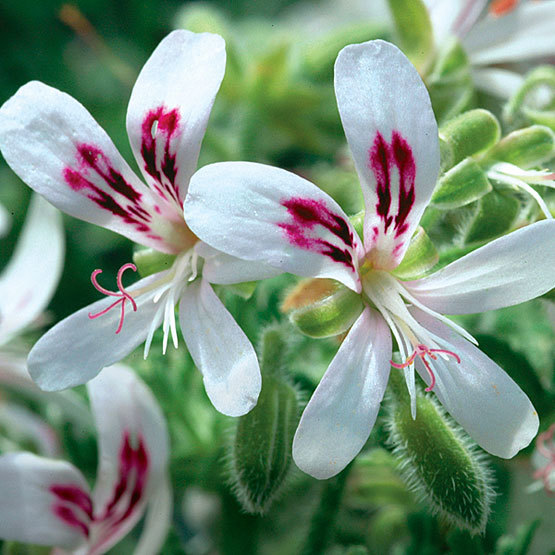
This genus of mostly evergreen perennials, shrubs, and succulents comes mainly from South Africa. The innumerable cultivars are divided into six groups—zonal, ivy-leaved, regal, angel, unique, scented-leaved, species, and primary hybrids—and they originate from roughly 20 species. They are staples for hanging baskets, summer bedding, and greenhouse displays, and the scented-leaved group includes many with edible foliage. They have terminal clusters of flowers with five petals, which may be shaped like saucers, stars, butterflies, trumpets, or funnels. Most bloom in spring or summer, but some may flower in winter if temperatures are kept around 45° to 50°F. Many have foliage with attractive markings and a distinct, rich aroma.
The common name of plants in the genus Pelargonium is geranium, which is also a common name of plants in the genus Geranium. This confusing situation stems from the fact that the plants in both genera were originally classified as Geranium.
For more information on scented geraniums:
Scented Geraniums
Growing Scented Pelargoniums
Plant Scented Geraniums for Flavorful Meals
Noteworthy CharacteristicsThis plentiful and charming genus offers plants with an abundance of flower colors and decorative leaf forms for both indoors and outdoors.
CareDeadhead spent flowers consistently. Outdoors: grow in neutral to alkaline, well-drained soil and preferably full sun (regals prefer partial shade; zonals tolerate some shade). In hot climates, provide midday shade. In cold climates, overwinter indoors and trim back by one-third; repot when growth resumes. Indoors: provide with a light soil mix, good light and ventilation, and midday shade. Fertilize every two weeks during growth, and water sparingly in winter.
PropagationRoot softwood cuttings in spring, late summer, or early fall. Sow seed from late winter to early spring at 70°F.
ProblemsSpider mites, thrips, mealybugs, caterpillars, mildew, gray mold, black leg, flower break virus, Xanthomonas blight, edema


























